Clover Lawn: Benefits and How to Grow Clover Lawn

Clover lawns are a low maintenance and eco-friendly alternative to regular grass lawns. Growing clover in a lawn has advantages because it requires less watering, fertilizing, and mowing. Rather than being a nuisance lawn weed, clover can help improve the look and function of your front or backyard lawn.
The two main types of clover used in lawns are white clover and microclover.
White clover (Trifolium repens) is sometimes called Dutch clover, shamrock or Irish clover. This broad leaf clover is a flowering creeping perennial plant in the pea family Fabaceae.
Microclover (Trifolium repens var. Pipolina) is a type of small clover with small leaves. Microclover blends well with grass and it helps to keep the lawn dense to suppress weeds.
White clover grows to between 3” and 6” (7 – 15 cm) tall. The mat-forming clover plant spreads quickly to cover large areas of ground. Clover is a cold-hardy, semi-evergreen plant that grows in zones 3 – 10.
Clover As a Lawn Alternative
Lush green lawns are a vital aspect of a home’s visual appeal. Green, natural ground cover turns bare ground into an attractive landscape. Lawns help to keep away unwanted plants and weeds. But grass lawns can be expensive to maintain. They require copious amounts of water, fertilizer, and plenty of hard work.
A clover lawn could be the solution to the problems of maintaining attractive green lawns. In years gone by, clover was one of the primary lawn plants in backyards. The spreading ground cover plant was easy to maintain without synthetic fertilizers and pesticides. It also tolerates drought better than turfgrass.
This article is a complete guide to grow clover lawns. You’ll find out how to incorporate clover in your current lawn or completely replace lawn grass with clover.
The Benefits of Having Clover Mixed in a Grass Lawn
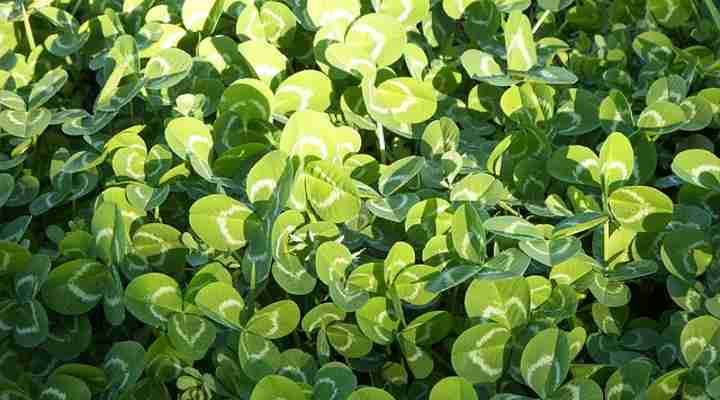
Having clover in a turfgrass boosts lawn nitrogen levels and suppresses weeds in the lawn
Some homeowners choose a lawn seed mix that contains a combination of grass and clover. Making your lawn more sustainable is one of the several benefits of adding clover to your grass lawn. Many gardeners use clover in grass to maintain and enhance existing lawns. A lawn that has patches of clover growing in it is generally healthier and greener than turfgrass alone. Also, mixed clover lawns require less fertilization and maintenance.
Here are the benefits of growing clover in lawn:
- Clover adds nitrogen to your grass lawn. Grass needs nitrogen to grow, and clover has a remarkable ability to boost lawn nitrogen levels naturally. Clover contains in its root system nitrogen producing bacteria. When the clover dies it releases this fixed nitrogen back to the soil, making it available for other plants.
- Clover growing in lawn reduces the need for fertilizing. When clover decomposes, it adds minerals to lawn soil, thus helping grass grow healthy, robust, and disease-resistant.
- Clover stays green throughout the summer. Unlike turfgrass—scorching summer sun won’t burn clover’s leaves.
- Clover suppresses weeds in lawn. Clover is a broadleaf plant which does a fantastic job of crowding out traditional lawn weeds such as dandelions.
What Is Clover and Why It Went Out of Style?
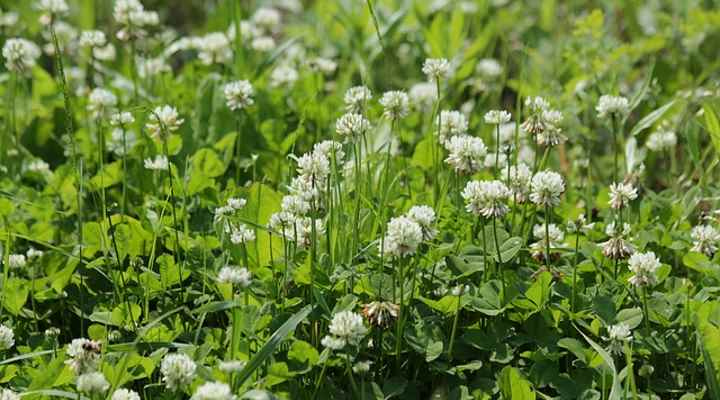
In the past white clover was common in lawn seed mixtures but went out of style when it was classed as a broadleaf weed in the 1950s
Years ago, clover wasn’t considered a weed. Lawn seed mixes used to contain a mixture of grass seed and white clover seed to grow healthy lawns. Clover used to be common in lawns because it is hardy, low growing and it helped grass grow without fertilizers.
White clover (Trifolium repens) has usually three or sometimes four small oval leaflets making up a leaf. Clover produces small white or pinkish flowers on the ends of stems. Clover forms a lush mat of green foliage. This perennial ground cover plant has a robust and extensive root system.
Clover was—and still is—the ideal complement to grass seed because it helps to fertilize the soil, thrives in poor soil, and survives drought conditions. So, before the 1950s, most lawns contained a combination of grass and clover.
Many gardeners consider clover a weed because it is considered an unwanted plant that spoils the manicured look of the lawn.
In the 1950s, clover became classed as a broadleaf weed. Many herbicides were promoted to help homeowners to get the perfect manicured lawn. The chemicals that targeted dandelions, crabgrass, chickweed, and other lawn “weeds” also killed off clover. So, gradually clover went out of style.
But clover lawns are now experiencing a revival. Many eco-conscious gardeners and lawn specialists recognize the advantages of using clover in lawns—either in pure clover lawns or mixed grass-clover lawns.
Advantages of Clover Lawn
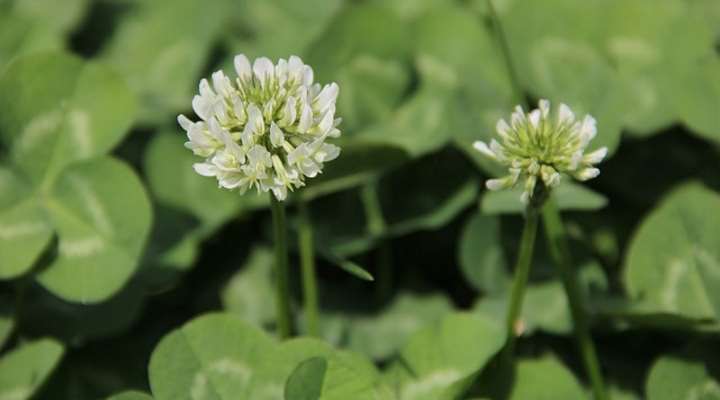
The main benefit of pure clover lawn is that it requires less maintenance than turfgrass and is more sustainable
Many homeowners choose to use pure clover lawn as an alternative to turfgrass rather than mixing clover and grass together. They do so mainly to save money and time on lawn care.
Clover lawns have several benefits compared to traditional turfgrass lawns.
Here are the main benefits of clover lawn:
- Clover lawns require less watering than grass lawn. Clover is on the list of drought-tolerant plants.
- Clover lawns don’t require fertilization. Legumes such as clover add nitrogen naturally to the soil. This “self-fertilization” process also benefits other plants and grasses growing nearby.
- Clover lawns rarely need mowing. Clover is a low growing ground cover plant that only grows a few inches tall. Mowing clover lawns is usually only necessary to prevent blooming or to tidy their appearance in summer.
- Clover lawns require minimal maintenance. Clover suppresses common lawn weeds. A clover lawn is also cheaper to look after because you don’t need to pay for herbicides, or fertilizers.
- Clover lawns stay greener for longer. Clover lawns are lush green from spring until fall. In southern states such as Florida, clover lawns stay green all winter.
- Clover lawns tolerate most soil conditions. Clover can grow in poor soil.
Once established, homeowners realize that a clover lawn has many advantages. The mat-forming clover feels like walking on a soft, lush carpet. Also, some people enjoy the flowers that attract pollinators in the summer. And pet owners soon realize that dog urine doesn’t discolor clover as it does regular grass lawns.
Disadvantages of a Clover Lawn
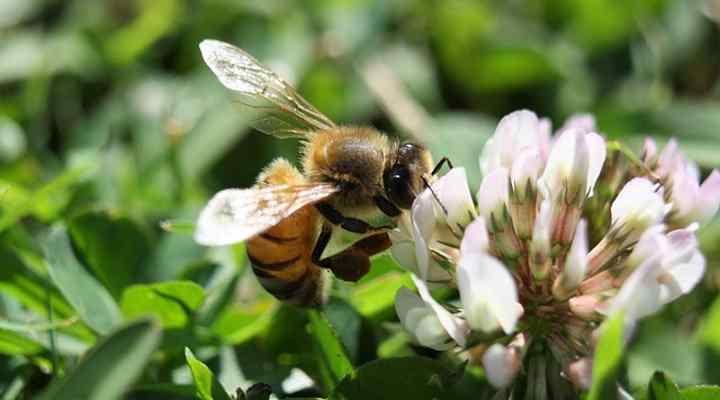
Clover lawn is less durable than turfgrass and the white clover flowers attract bees which may sting you if you go barefoot
The main disadvantage of a clover lawn is its durability. Clover lawn doesn’t stand up to heavy foot traffic. Another downside of clover is related to its flowers that attract bees that can sting you. This is an issue if you like to go barefoot on the lawn as you might get stung. Another drawback of clover in lawn is that it stains clothes.
Of course, mowing clover lawns before they blossom will eliminate the “bee problem.” You could also grow pure clover lawns instead of grass in garden areas that don’t get heavy foot traffic.
Clover Vs. Grass
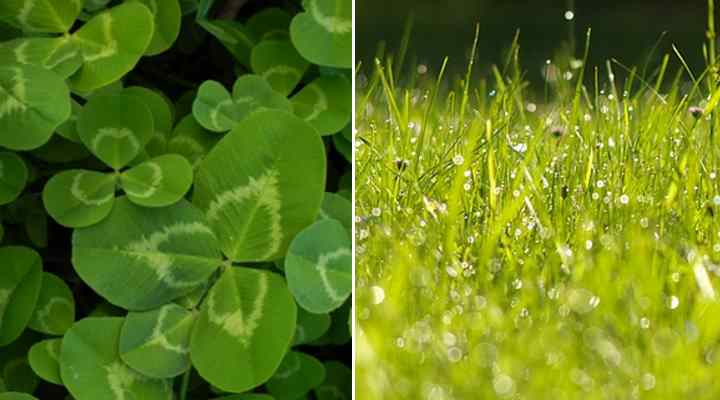
How do clover lawns and grass lawns compare if you want lush, green ground cover for your front or back yard?
Here are some of the differences between grass and clover:
Clover is easier to care for than grass. Clover naturally chokes weeds, and you need to spend less time weeding. Compared to turfgrass lawns, clover lawns rarely require mowing.
Clover tends to stay greener for longer. Unlike grass, the sun doesn’t scorch clover during hot, arid summers. Also, clover is resistant to dog urine and doesn’t lose its color or die off. Generally, clover lawns are less “patchy” than grass lawns.
Clover is cheaper to maintain than grass. Clover lawns don’t need as much water—saving you time and money. Also, you don’t need to buy fertilizers or herbicides for lawn care if you grow clover lawns.
Grass is neater than clover. Bluegrass or Bermuda grass lawns tend to have a neater appearance. Sometimes, clover lawns can appear unkempt or untidy. Deciding whether to grow clover instead of grass depends on the type of garden landscape you want to achieve.
Grass is more durable than clover. Comparing grass to clover, it’s clear that most grass types withstand foot traffic better than clover. However, some kinds of microclover plants are more tolerant of foot traffic that other lawn alternatives. And, in any case, very heavy foot traffic affects grass as much as it does clover.
Clover can grow in poor soil, however grass needs soil that retains nutrients. Grass also needs soil that holds enough moisture, be well-draining and allow air flow.
The Types of Clover Lawn
The two main types of clover used in lawns are white clover (Trifolium repens), also called Dutch or dwarf white clover, and microclover (Trifolium repens var. Pipolina). Both clover varieties are ideal lawn alternatives if you want to avoid planting grass.
What Is Microclover?
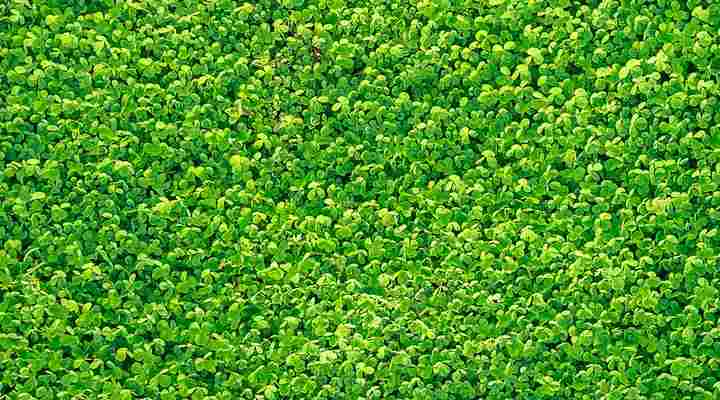
Microclover lawn
Microclover (Trifolium repens var. Pipolina) is a flowering semi-evergreen ground cover plant. Microclover is becoming a more common addition to lawns because it’s cold-hardy perennial that grows as a dense, lush mat to cover bare ground or grow with grass.
Microclover is a clover cultivar that blends well with grass lawn because it has smaller leaves, fewer flowers, and a shorter height than regular white clover.
- Microclover thrives in full sun, but also grows well in shade
- Microclover produces fewer flowers compared to white clover
- Microclover is more tolerant of foot traffic than white clover
- Microclover has shorter height than regular white clover
- Microclover may turn brown in winter
To grow a clover lawn using microclover, you’ll need about 1 lb. of seeds for 300 – 600 square feet (0.45 kg for 27 to 55 square meters).
What Is White Clover (Dutch Clover)?
Dutch clover (Trifolium repens) is another name for white clover. This spreading plant is becoming popular again as a lawn alternative. The small leafy foliage grows up to 6” (15 cm) and has a spread of up to 2 ft. (60 cm). Dutch clover blooms profusely with creamy-white flowers.
Other common names for Dutch clover are honeysuckle grass, creeping clover, shamrock, and common clover.
Here are the main features of Dutch clover:
- Dutch clover stays green throughout the year in warm climates
- Dutch clover grows in full sun and partial shade
- Dutch clover withstands summer scorching
- Dutch clover blooms from spring through fall
- Dutch clover may require reseeding after a few years; however, that may depend on your area
To grow a clover lawn using Dutch clover or white clover, you’ll need about 1 lb. for 1,000 square feet (0.45 kg for 92 square meters).
How to Add Clover to Existing Lawn
Add clover to your existing lawn by seeding over your lawn in spring so that clover begins to grow. To prepare your lawn for clover seeding, mow the grass close to the ground. Then rake out previous season’s thatch. Aerate turfgrass soil to allow clover to take root better.
Combine white clover seed or microclover seed with sand. Spread the clover evenly over the lawn by hand or use a lawn spreader on the finest setting.
After planting clover seed on your lawn, water every day for two weeks. Regular watering helps seeds to germinate, take root, and establish clover in your lawn.
Clover is a ground cover lawn plant for partial shade or full sun. You can add it to lawns on south-, east, or west-facing gardens. Clover can also grow in the shade, but it’s better to seed a lawn with microclover for shaded yards.
How to Plant a Clover Lawn
You can grow an easy-care, low-maintenance pure clover lawn by seeding bare soil with clover seed. Prepare your soil in early spring by turning it over to remove stones, weeds, and other debris. Water the ground and wait a few days for any weeds to sprout. Remove these as necessary.
Combine clover seed with fine soil, sand, or sawdust—this helps to spread clover easier. You will need about 2 oz. (57 g) of clover seed for 1,000 square feet (92 square meters) of the lawn. Spread the clover seed evenly over the ground. Use a rake to smooth the soil and lightly cover the seeds.
Once the clover seeds are planted, water thoroughly. Watering newly-seeded ground helps the clover to stick in the soil and encourage germination. Lightly water the soil daily to promote rapid growth.
How to Maintain a Clover Lawn
Clover lawns are easy to maintain once established. If you need to mow your white clover lawn, set the mower’s blades to about 2” (5 cm). You don’t need to collect clover clippings as they will decompose and return nutrients to the soil.
Clover lawns only require light maintenance in the summer with occasional mowing to prevent flowers from blooming. However, that is only necessary if you want to discourage bees.
If you’re happy with bees and flowers on your lawn, you can sit back and relax to enjoy your low-maintenance clover lawn.
Related articles:
